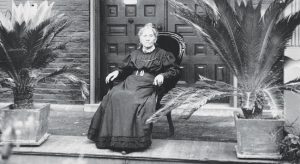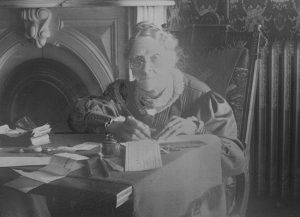
photo by Special Collections. Bradley University Library
Frontier explorer. Philanthropist. Businesswoman. University foundress.
Lydia Moss Bradley was many things – and among them, a feminist. Ahead of her time in many ways, Lydia paved the way for generations of students and community members far after her life.
After her husband’s death in 1867, Lydia took over his open seat on the board of directors at Peoria’s First National Bank, making her the first female member of a national bank board in the United States.
Lydia was also a driven philanthropist. The money she used to help fund various organizations was initially attained from her late husband’s estate settlement, which consisted of 700 acres of land in Peoria. Totaling around $500,000, Lydia continued to use her entrepreneurial experience to more than double those funds, later becoming a self-made millionaire.
In 1869, just before marrying her second husband Edward Clark, Lydia Moss Bradley became the first American woman to draft a prenuptial agreement to protect her assets. She was savvy enough to be careful with her wealth and was unwilling to place herself in a position of vulnerability. The agreement, which Clark signed, declared if the marriage did not last, each would retain their individual holdings. Lydia and Clark divorced in 1873.

photo by Special Collections. Bradley University Library
Additionally, Lydia opened the Bradley Home for Aged Women to care for widowed and childless women, as well as deeded the land to form Laura Bradley Park. She donated money to places like the Universalist Church, paying off their $30,000 mortgage, and invested $15,000 in the Grand Opera House in downtown Peoria. She also donated an amount of estate money to the Society of St. Francis to build a hospital – now known as OSF St. Francis Medical Center.
Of course, Lydia’s greatest achievement was in the founding of Bradley University, originally the Bradley Polytechnic Institute, in 1897.
But her legacy lives on past the 19th century.
Lydia was inducted into the National Women’s Hall of Fame in 1998, nominated by then-university president John Brazil for her business and philanthropic spirit. The hall of fame’s induction ceremony was the largest of its time with 21 inductees, and it was also the 150th anniversary of the Women’s Right Convention.
Lydia’s life achievements lent to her being a woman ahead of her time, and her accomplishments can still be seen around Peoria today.



